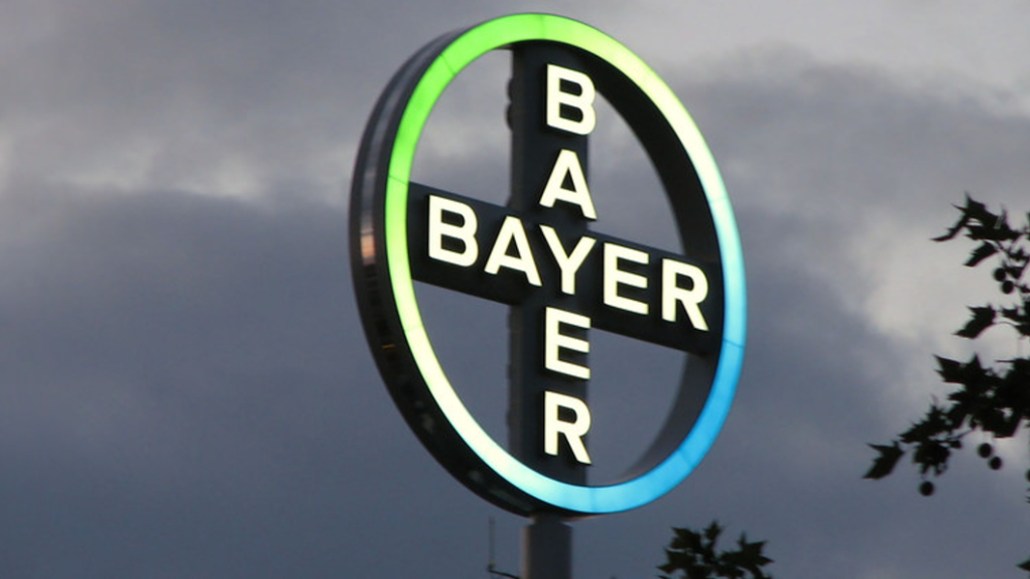Save 50% on a 3-month Digiday+ membership. Ends Dec 5.

Bayer’s in-house agency is changing where the company’s digital advertising shows up, adding more retail media channels to the media mix, after seeing consumer behavior shift to online shopping in mid-March and all throughout April.
“We’re testing out a broad array of online shopping partners and retail media partners,” said Josh Palau, head of media, digital platforms and content for Bayer in North America. “Our industry is one that typically drives sales through a store visit and we’re not seeing store visits so we’re trying to connect people as closely as possible to getting information and product.”
That shift in media spending is one way the pharmaceutical giant’s in-house agency is adapting to the new reality. The in-house agency also has staff checking in with other companies’ in-house agencies to see how they are shifting spending as well as changing its overall strategy to make sure its brands’ advertising is “present and useful” for consumers.
Over the last two years, Bayer has been growing its in-house agency. While Mediacom is still responsible for TV, OTT and all connected TV buying, the in-house agency handles all buying and planning for programmatic, analytics, search and TV strategy. In recent months, Bayer has added retail media experts as well as digital creatives to its in-house team; Palau declined to share the size of the in-house team now but did say that the company is still looking to hire for its open programmatic, search and analytics positions.
Same budget but more retail media
The company hasn’t increased its advertising spending (Palau declined to share the size of the budget) to add more retail media to the mix. Instead, the budget has stayed consistent and the team is examining social, search, online video and programmatic channels to figure out where it can move some of its spending to retail media without having a negative impact on the other channels.
Typically, the in-house agency makes budget allocation decisions based on an internal attribution model that measures exposure and online purchase behavior for a particular channel. However, the agency added more retail media channels like Instacart without being able to rely on that model this time.
Ad position: web_incontent_pos1
“There were a few platforms we’ve never used before that aren’t approved for our attribution model but we know consumers are shopping there,” said Palau. “We’re not going to be the [company] that’s not showing up there because it’s not measurable or we don’t have an ROI model against it. We need to be where consumers are shopping in order to get the information to them.”
The in-house agency hasn’t made any other major budget shifts yet but has observed lower ad prices for Facebook and Google and may move more dollars there. “We’ve always shifted money based on ROI,” said Palau. “We’re seeing auction dynamics play out the way everyone else is and we’re definitely evaluating if there are places for us to increase reach.”
Be present and useful
The advertising shift is part of the company’s overall strategy to not only be “present” but “useful” to consumers with how it shows up during this time.
“Considering we are in the health space, it’s even more important that we adapt our approach to ensure that consumers are able to get the products they need,” said Palau. “Present meaning that we are there in all places that they are looking for information and useful in that we are giving them the information they need to determine what product makes sense for them and where they can safely buy it.”
Ad position: web_incontent_pos2
Given that much of the messaging for the products is already geared toward how the products can help consumers, the in-house shop hasn’t tweaked much of its digital advertising copy to adopt the current strategy. That’s not to say the copy won’t change but that the in-house agency is looking to be thoughtful about what the copy is saying and how it could be perceived right now.
“Our existing creative talks about the benefits of our products for relief if you’re suffering from pain, allergies or congestion,” said Palau. “[It] delivers a message of what our products do already and that’s a fine message for us to put out there.”
Checking in with other in-house agencies
To get a sense of how other in-house agencies are managing their businesses advertising during this time, Palau and his team are doing check-ins. Last week, the company did a “speed dating” round of meetings with its top partners to understand what changes they’re seeing in user behaviors both in shopping and media consumption so that the company could optimize its plans and ensure it is providing helpful information to consumers during this time.
Of course, that’s not unusual for the team. “Even before [coronavirus], we had a regular cadence of meetings with partners,” said Palau. “Several of us meet regularly with peers at other companies – several of which are not in our industry – to stay connected to what is happening outside of Bayer.”
More in Marketing

Ulta, Best Buy and Adidas dominate AI holiday shopping mentions
The brands that are seeing the biggest boost from this shift in consumer behavior are some of the biggest retailers.

U.K. retailer Boots leads brand efforts to invest in ad creative’s data layer
For media dollars to make an impact, brands need ad creative that actually hits. More CMOs are investing in pre- and post-flight measurement.

‘AI is permeating everything we do’: How Guitar Center developed 2 AI tools this year
This summer, the company launched a chatbot called Rig Advisor to help customers find the right instruments and products.
Ad position: web_bfu


